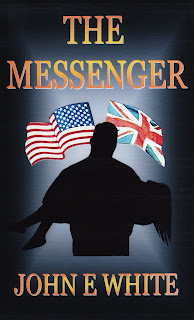I am no political animal, I am a father and grandfather and like any user of the Internet I can see the devastation that war causes. Children without limbs, clumps of severed veins and arteries where feet and hands used to be, faces cut to ribbons - parents killed or maimed. If you can think of it, a child has suffered it - is suffering it. Rarely do we see these images on the news or in the media because they don't make for good television - or good Government. But when I see those images I can't help thinking of my children and grandchildren and how wretched that would be for them. What also hurts is the fact that I have no influence on the world leaders and politicians whose agendas create this mayhem.
So, in 2006, when friend and fellow author, Robert Shove gave me the idea of a soldier driven to turn the world to peace I wanted to write the story. I wanted to create a vehicle to carry the concept which might make people think harder about war and its repercussions. How to do it? I remembered reading that Plato is attributed with the statement: 'Only the dead know the end of war'. This truism struck a cord with me and I knew that I wanted Jack Chandler's first excursion onto the page to challenge it. Linking Jack's dilemma to a flawed US plan to invade Iran gave me the vehicle I needed.
However, during the following four years, the changing situation in the Middle-East, Iran's nuclear revelations and the posturing of Western Governments often made me wonder if I was writing fiction or history.
During 2010 I began selecting agents and making submissions - 19 of them over a period of 9 months! Three agents asked to see the full manuscript - the most helpful being Camilla Wray of Darley Anderson, but despite her enthusiasm for Jack Chandler and the the US invasion plot - she wasn't keen on the other-world sub-plot. She asked if I would take it out. I did and it took almost two months of rewrite to do it, but no matter how I looked at it then, The Messenger just wasn't the same story - it had, quite literally, lost its soul. So, I put the soul(s) back in ... but the lack of the right agent did make me wonder (a) if I had been arrogant in hoping that my book would make people think harder about war and (b) whether my story (sub-plot included) would ever see the light of day.
Then, along came Amazon Kindle publishing. It was free to use, paid commission to authors and no agents were needed. I knew The Messenger had a chance.
I designed the cover, using the outline from a picture of a man carrying an injured child. I hoped it would provided a visible link from The Messenger to the real face of war. And, thinking of faces, in the story Jack tries to save a young Iraqi girl, Leyla, but she dies in his arms - an event that haunts him. All the time I was writing Leyla's character I couldn't get the image of a terrified young girl out of my head. I found her photograph amongst many, more graphic, images of children who had been physically and mentally devastated by conflict. I have no idea who the photographer is or who this child is - all I do know is that her look of of fear and helplessness makes me know that war should be the very last resort and certainly never for profit.

If the photographer who took this picture would like to email me (white4wordart@aol.com) I will either place the credit and copyright details on here or remove the picture if he /she requires.
